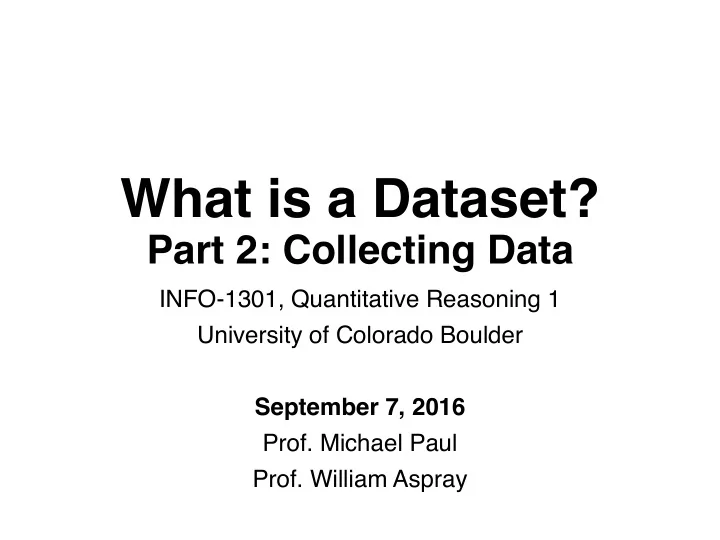

What is a Dataset? Part 2: Collecting Data INFO-1301, Quantitative Reasoning 1 University of Colorado Boulder September 7, 2016 Prof. Michael Paul Prof. William Aspray
Administrivia Quiz 1 on Friday • Covers everything up to and including today • Problems will be similar to homework • Review lecture slides online, plus readings • Be comfortable with the exercises in the book • Office hours this week (ENVD 207): • Wed. 11am-noon: Prof. Aspray • Thurs. 10am-noon: Prof. Paul
Overview This lecture will… • get you thinking about where data comes from, • and introduce concepts of populations and sampling. How to collect data is a huge topic – you could take an entire course on it. This is just a starting point.
Data collection: an example ‘Spanish flu’ of 1918 • 20-50 million deaths worldwide • Precise numbers are unknown (due to lack of data) • Not much known at the time about how to control epidemics • We know more now • … thanks to years of data to aid our understanding
Data collection: 1918 Image from: http://nyamcenterforhistory.org/tag/spanish-flu/ This type of data is called anecdotal evidence
Data collection: 1980s-Present Flu cases monitored in depth by the federal government • Data from the Centers for Disease Control and Prevention (CDC)
Data collection: 1980s-Present How does the CDC get this data? • A number of healthcare providers across the country report numbers to the CDC each week • Approximately 50 clinics per state • The CDC then has a snapshot of influenza in the US from the past week
Data collection: 2010s-Present Search queries: Twitter posts: A recent innovation: Internet data as an alternative to hospital data • We know when someone has the flu because they said so online
Data collection: 2010s-Present
CDC vs Twitter • Which is more accurate? • The CDC is accepted as the gold standard • What does it mean to be accurate? • What we observe vs what is true • Which is “better”? • Speed/cost vs accuracy Using both data sources together is actually more accurate than only one of them alone • Why? We’ll think about it again later.
Populations A population is a set of potential observations/cases A target population is the population that is needed to answer a particular question Example: • Question: What is the average income of Colorado residents? • Target population: Set of all Colorado residents
Populations Populations don’t have to be people More examples: • What percentage of HP computers are defective? • Target population: set of all HP computers • What is the average level of mercury in salmon? • Target population: set of all salmon
Samples Sometimes it is impossible or impractical to collect data from an entire population A sample is a subset of a population Example: • Question: What is the average income of Colorado residents? • Target population: Set of all Colorado residents • Sample: 1,000 randomly selected Colorado residents
Samples A sample is a subset of the target population Sample Target Population
Samples Most datasets are samples Common examples: • Being randomly selected to give feedback to a company on a recent purchase • Phone questionnaires from polling companies (e.g., to collect political opinions) • Estimates of TV viewership or radio listenership The process of collecting data about an entire population (no sampling) is called a census
Samples Simple random sampling from the target population produces an unbiased sample of that population A unbiased sample is considered representative of the target population Statistics computed from unbiased samples are expected to be “close” to the population statistics • We’ll explain this more rigorously later in the course
Samples The sampling frame is the set from which you sample • It is a subset (or equal to) the target population • Example: If you randomly sample residents from Colorado, the sampling frame is the set of Coloradans If the sampling frame is different from the target population, then the sample will be biased • Example: You want to measure the average income of Americans, but you only sample people from Colorado
Samples The sampling frame is a subset of the target population A sample is a subset of the sampling frame Sample Sampling Frame Target Population
Returning to flu… Research question: • What percentage of Americans are currently infected with the flu? Target population? • Set of all Americans
Flu data: CDC Recall: how does the CDC collect their data? • A number of healthcare providers across the country report numbers to the CDC each week • Approximately 50 clinics per state What is the sampling frame? • People who have visited a U.S. healthcare clinic in the past week • Not exactly the same as the target population – not everyone with flu goes to see a doctor
Flu data: Tweets Where does the Twitter data come from? • People tweet that they are sick What is the sampling frame? • People who use Twitter and choose to tweet about their health status • Clearly not the same as the target population, since many people are not included
CDC data: Tweet data: Sample Sample Patients Twitter Users Americans Americans
Combined data: The sampling frame is closer to the target population • Less biased Sample This is why sampling from multiple data sources can be better Union of Patients than just one and Twitter Users Americans
Recommend
More recommend